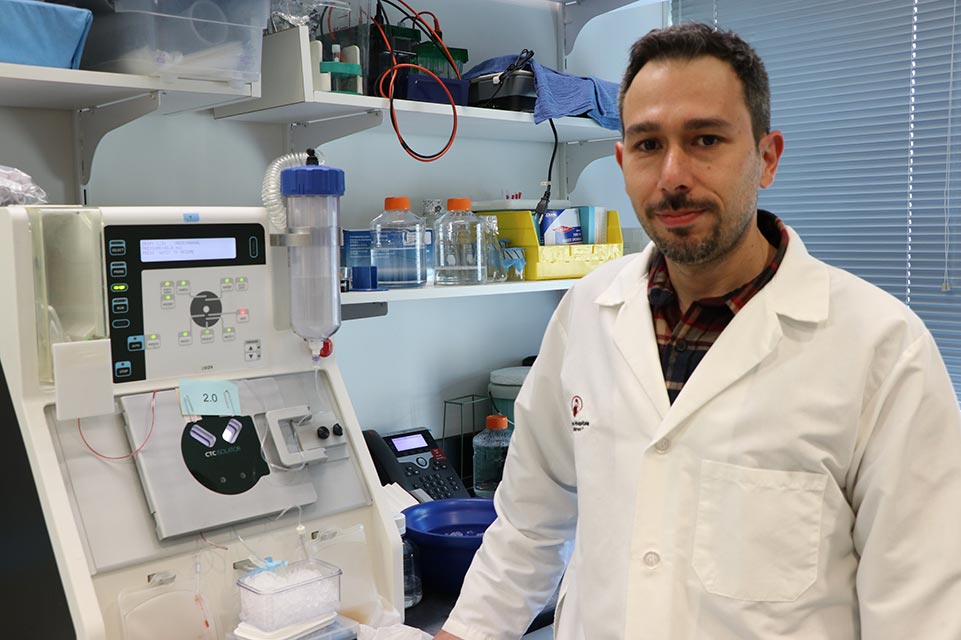Curiosity and Drive Put Shriners Children’s Boston Researchers at the Forefront of Innovation and Discovery
As a young child, Murat Karabacak looked at objects and pondered, "How can I make this? What is this composed of?" He was fascinated by the ingredients in his favorite foods and wondered how taste worked. He also wondered how the trillions of cells in his body could form a hand or even a lung. The idea of understanding matter riveted him. Murat's fascination with science led him to study chemistry at Bilkent University in Turkey, his home country. Murat came to Boston for a physics internship at Harvard University during his junior year. He fell in love with the rich culture and myriad opportunities for scientists in the city.
After earning his Ph.D. in chemistry with a specialization in quantitative biology from Brandeis University, Dr. Karabacak joined the Center for Engineering and Surgery as a postdoctoral fellow in 2011. He was promoted to Instructor in Surgery at Harvard Medical School in 2016. He also joined the research team at Shriners Children’s Boston and currently helps oversee the mass spectrometer facility.
The field of mass spectrometry is about measurement. Thinking back to Dr. Karabacak's childhood curiosity, mass spectrometry can help answer those questions by measuring one of the most simple properties of matter, mass. Mass analysis can help decipher the makeup of matter from objects to humans. At Shriners Children’s Boston, the state-of-the-art mass spectrometer (technically, a triple-TOF LC/MS) allows researchers to discover metabolic and signaling pathways more comprehensively for various biomedical applications. These applications include determining the cause of hypermetabolism after burn injury, understanding the underlying mechanism of wound healing following burn injuries, or evaluating immune responses during sepsis and graft rejection.

Dr. Karabacak oversees the mass spectrometer facility at Shriners Children's Boston.
Scientists of the past decade have noticed that cell behavior is complex and variable. Researchers must now examine single cells to investigate how they act. One crucial question is to identify ways to efficiently use stem cells that have the potential to regenerate damaged organs for patients with critical illness and injury. Modern mass spectrometers have reached the sensitivity to enable the analysis of single cells. At Shriners Children’s Boston, Dr. Karabacak and other scientists look at stem cells and their application to wounds and burn injuries. There is a significant need for larger skin transplants for patients with extensive surface area burns. The mass spectrometer enables scientists to determine if the organs and stem cells to be transplanted are in the best condition.
The stem cell project asks only one of many questions that Shriners Children’s Boston researchers are tackling. The mass spectrometer is the tool that enables analysis for these current studies as well:
- Identifying the best nutritional support composition and timing to support critically wounded patients
- Limb and organ preservation and transplantation
- Identifying biomarkers for bacterial infections
- Early diagnostic for heterotopic ossification, a devastating consequence of burn and traumatic injuries
- Cell to cell analysis: why cells do not act in a consistent manner
- Working with the pharmacy to identify the best storage conditions for some medications
- Analysis of drugs in zebrafish models to help understand drug metabolism
At Shriners Children’s Boston, the research facility is filled with dedicated scientists like Murat Karabacak, who started as curious children, pondering big questions and devoting their careers to finding answers. This talent and drive have put Shriners Children’s Boston at the forefront of innovation and discovery, a path that will continue to benefit our patients for years to come.
Keep In Touch
Join our mailing list to stay up to date on everything that's happening at Shriners Children's.
